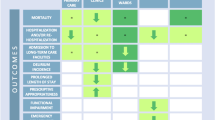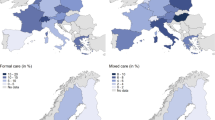Abstract
Introduction
Elder abuse is associated with impaired physical and psychological health. It is, however, rarely identified in emergency departments (EDs). The objective was to determine the prevalence and the predictors of elder abuse among older adults visiting EDs.
Methods
This prospective cohort study was conducted in eight Canadian EDs between May and August 2021. Patients were eligible if they were ≥ 65 years old, oriented to time, and with a Canadian Triage and Acuity Scale score 3, 4 or 5. In a private setting, participants were questioned directly about abuse as part of a larger questionnaire exploring ten non-medical problems. We used multivariable logistic regression to identify predictors of elder abuse.
Results
A total of 1061 participants were recruited (mean age: 77.1 (SD 7.6) years, female sex: 55.7%, lived alone: 42.5%). Patients mostly attended EDs for pain (19.6%), neurologic (11.3%) or cardiovascular (8.4%) symptoms. The most frequent pre-existing comorbidities were hypertension (67.2%), mental health conditions (33.3%) and cardiac insufficiency (29.6%). Mobility issues outside (41.0%) or inside their home (30.7%) and loneliness (29.4%) were also frequent. Fifty-four (5.1%) participants reported elder abuse, of which 34.3% were aware of available community-based resources. Identified predictors of elder abuse were female sex (OR 2.8 [95%CI 1.4; 5.6]), financial difficulties (OR 3.6 [95%CI 1.8; 7.3]), food insecurity (OR 2.7 [95%CI 1.2; 5.6]), need for a caregiver (OR 2.7 [95%CI 1.5; 5.0]) and at least one pre-existing mental health condition (OR 2.6 [95%CI 1.4; 4.9]).
Conclusion
When questioned directly, 5.1% of older adults attending EDs reported experiencing abuse. Female sex, functional impairment, social vulnerability, and mental health comorbidities are associated with elder abuse. Given its importance and relatively high prevalence, ED professionals should have a low threshold to ask directly about elder abuse.
Résumé
Introduction
La maltraitance des personnes âgées est associée à une détérioration de la santé physique et psychologique. Elle est cependant rarement identifiée dans les services d'urgence. L’objectif était de déterminer la prévalence et les prédicteurs de l'abus envers les aînés chez les personnes âgées qui consultent dans un service d’urgence.
Méthodes
Cette étude de cohorte prospective a été menée dans huit services d'urgence canadiens entre mai et août 2021. Les patients étaient éligibles s'ils étaient âgés de ≥ 65 ans, s'ils étaient orientés vers le temps et s'ils avaient un score de 3, 4 ou 5 sur l'échelle canadienne de triage et d'acuité. Dans un cadre privé, les participants ont été interrogés directement sur la maltraitance dans le cadre d'un questionnaire plus large explorant 10 problèmes non médicaux. Nous avons utilisé une régression logistique multivariable pour identifier les facteurs prédictifs de la maltraitance envers les personnes âgées.
Résultats
Au total, 1 061 participants ont été recrutés (âge moyen : 77,1 (SD 7,6) ans, sexe féminin : 55,7 %, vivant seul : 42,5 %). Les patients se sont surtout rendus aux urgences pour des douleurs (19,6 %), des symptômes neurologiques (11,3 %) ou cardiovasculaires (8,4 %). Les comorbidités préexistantes les plus fréquentes étaient l'hypertension (67,2 %), les problèmes de santé mentale (33,3 %) et l'insuffisance cardiaque (29,6 %). Les problèmes de mobilité à l'extérieur (41,0 %) ou à l'intérieur du domicile (30,7 %) et la solitude (29,4 %) sont également fréquents. Cinquante-quatre (5,1 %) participants ont signalé des cas de maltraitance des personnes âgées, dont 34,3 % connaissaient les ressources communautaires disponibles. Les facteurs prédictifs identifiés de maltraitance envers les personnes âgées étaient le sexe féminin (RC 2,8 [IC 95 % 1,4 ; 5,6]), les difficultés financières (RC 3,6 [IC 95 % 1,8 ; 7,3]), l'insécurité alimentaire (RC 2,7 [IC 95 % 1,2 ; 5,6]), besoin d'un aidant (RC 2,7 [IC 95 % 1,5 ; 5,0]) et au moins un problème de santé mentale préexistant (RC 2,6 [IC 95 % 1,4 ; 4,9]).
Conclusion
Interrogées directement, 5,1 % des personnes âgées fréquentant les urgences ont déclaré avoir été victimes de maltraitance. Le sexe féminin, les déficits fonctionnels, la vulnérabilité sociale et les problématiques de santé mentale sont associés à la maltraitance des personnes âgées. Compte tenu de son importance et de sa prévalence relativement élevée, les professionnels des urgences ne devraient pas hésiter à poser directement des questions sur la maltraitance aux personnes âgées.
Similar content being viewed by others
Data availability
The data that support the findings of this study could be available from the corresponding author, [EM], upon reasonable request.
References
Yon Y, Mikton CR, Gassoumis ZD, Wilber KH. Elder abuse prevalence in community settings: a systematic review and meta-analysis. Lancet Glob Health. 2017;5(2):e147–56.
Dong X, Simon MA. Association between elder abuse and use of ED: findings from the Chicago health and aging project. Am J Emerg Med. 2013;31(4):693–8.
Mercier E, Jones A, Brousseau A, Hirdes J, Mowbray F, Emond M, et al. LO13: Characteristics of emergency department visits by community-dwelling older adults who screened positive for elder abuse during home care assessments. Can J Emergency Med. 2019;21(S1):11.
Mercier É, Nadeau A, Brousseau AA, Émond M, Lowthian J, Berthelot S, et al. Elder abuse in the out-of-hospital and emergency department settings: a scoping review. Ann Emerg Med. 2020;75(2):181–91.
Tanguay KNA, Brousseau AA, Archambault PM, Emond M, Deshaies JF, Mercier E. LO57: prevalence of nonmedical needs among older adults visiting the ED for a low acuity condition: a prospective multicenter cohort study CAEP/ACMU 2022 Scientific Abstracts. Can J Emergency Med. 2022;24(1):S27–8.
Lai X, Liu L. A simple test procedure in standardizing the power of Hosmer-Lemeshow test in large data sets. J Stat Comput Simul. 2018;88(13):2463–72.
Stevens TB, Richmond NL, Pereira GF, Shenvi CL, Platts-Mills TF. Prevalence of nonmedical problems among older adults presenting to the emergency department. Acad Emerg Med Off J Soc Acad Emerg Med. 2014;21(6):651–8.
Burnes D, Pillemer K, Rosen T, Lachs MS, McDonald L. Elder abuse prevalence and risk factors: findings from the Canadian longitudinal study on aging. Nature Aging. 2022;2(9):784–95.
Dong X, Simon M, Rajan K, Evans DA. Association of cognitive function and risk for elder abuse in a community-dwelling population. Dement Geriatr Cogn Disord. 2011;32(3):209–15.
Johannesen M, LoGiudice D. Elder abuse: a systematic review of risk factors in community-dwelling elders. Age Ageing. 2013;42(3):292–8.
Acknowledgements
We would like to acknowledge the work of Leila Adam, Pénélope Haguette and Jeanne Lavallée who helped with the recruitment for this project.
Funding
This study was funded by Réseau-1 Québec (Projets de développement, 2020).
Author information
Authors and Affiliations
Contributions
EM, KT and AN wrote the study protocol with inputs from all other authors. AAB, JFD, ME, PMA, PGB and AB supervised the recruitment. SG, KT, PHC, FIM and AN compiled data and performed the statistical analysis with inputs from all other authors. SG, AN and EM drafted the first version of the manuscript. All authors contributed substantially to its revision. EM takes responsibility for the paper as a whole.
Corresponding author
Ethics declarations
Conflict of interest
The authors have no conflicts of interest to declare.
Additional information
Communicated by Daniel K. Ting.
Supplementary Information
Below is the link to the electronic supplementary material.
Rights and permissions
Springer Nature or its licensor (e.g. a society or other partner) holds exclusive rights to this article under a publishing agreement with the author(s) or other rightsholder(s); author self-archiving of the accepted manuscript version of this article is solely governed by the terms of such publishing agreement and applicable law.
About this article
Cite this article
Gagnon, S., Nadeau, A., Tanguay, K. et al. Prevalence and predictors of elder abuse among older adults attending emergency departments: a prospective cohort study. Can J Emerg Med 25, 953–958 (2023). https://doi.org/10.1007/s43678-023-00600-4
Received:
Accepted:
Published:
Issue Date:
DOI: https://doi.org/10.1007/s43678-023-00600-4




